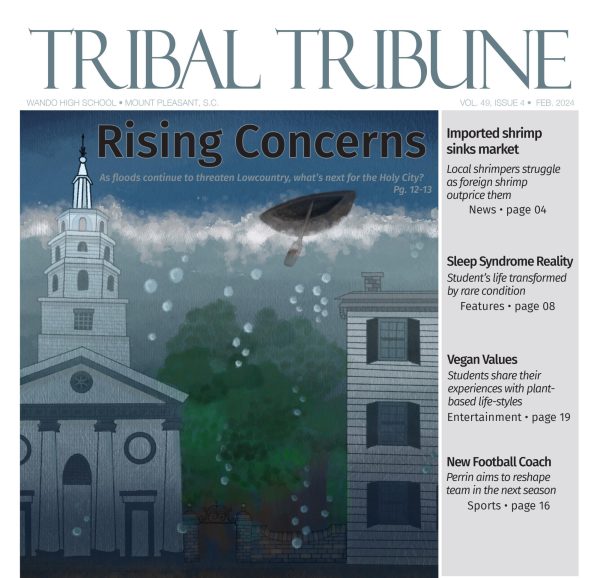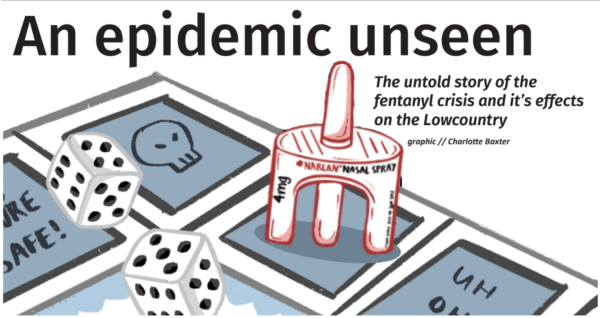Charleston’s Withering Waterways
Population growth hits hard on crucial ecosystem
“Save Shem Creek Corp. is a nonprofit organization dedicated to protecting the iconic waterway that serves as the cultural heart of Mount Pleasant. The organization believes that Town leaders should respect and adhere to established guidance documents put in place to safeguard the waterway,” said Save Shem Creek Corp in the description of their post on a fundraising website.
For a place that relies heavily on natural waterways, Charleston continues to neglect the physical features that are its home to prioritize the developing demand of gentrification.
To help prevent Charleston’s ecosystem from destruction and pollution, nonprofit organization Charleston Waterkeeper works to keep local waterways and habitats clean, healthy, and protected.
Andrew Wunderley, executive director and waterkeeper of Charleston Waterkeeper, stands up for and defends every body of water that is in Charleston.
“To have one identifiable person that speaks for and on behalf of local waterways and that’s what that’s what I do in that role. I speak on behalf of Charleston’s waterways,” Wunderley said.
Charleston Waterkeeper protects the ecosystem in various ways through manual labor and voluntary services yet sometimes, speaking out through the use of public and legal action is the best method when it comes to larger issues.
“We sued a big company that was selling nurdles as little plastic pellets into our waterways a couple years ago and won a big settlement over that… it’s using whatever tool works, whether it be public advocacy or legal advocacy,” Wunderley said.
Unfortunately, microplastics aren’t the only danger to Charleston’s nature. With an increase in population and tourism in Charleston, a high demand for new housing and businesses takes over not just homes for locals, but habitats for wildlife.
“We are radically altering the way the land and water work together by covering it with impervious surface and so rainwater and floodwater can’t soak through the ground of a parking lot, or our apartment complex, or a new neighborhood,” Wunderley said.
Although people are drawn to Charleston for its environment, due to the fact that these new developments that are dominating Charleston, it makes it extremely difficult to protect the water and habitat quality of local creeks, rivers, harbors, and marshes.
“In the last 20 years I’ve just seen explosive growth… by moving here and growing, we’re threatening the very thing that makes our community so special,” Wunderley said.
Recent communities that are constructed quickly and cheaply to keep up with the high demand of incoming residents all have one underlying factor that damages everything around it.
“Every family gets their own house, but they’re jammed in really close together with small front yards and small backyards and almost no separation between the houses on the sides. Instead of having sewer service for wastewater, toilets, sinks and showers, they’re using septic tanks,” Wunderley said.
The style in which the new developments are being rapidly assembled have major negative effects to not only the water system in which Charleston relies on, but the residents who consume the same water.
“There’s a chance for your septic tank to come either to contaminate your well, which can really lead to problems of public health. You can get really sick from drinking untreated water that’s contaminated by human waste,” Wunderley said.
Citizen’s health is in jeopardy due to septic tank contagion for the reason that South Carolina attains one of the weakest septic tank regulations in the southeast.
“Alabama has a minimum lot size for a septic tank of an acre. Here, we don’t even have a minimum lot size. You only need six inches of soil between your drain field and the groundwater table,” Wunderley said.
Jessica Anderson, an AP Environmental Science teacher at Wando, believes one of the most important issues when it comes to crowded construction, like downtown Charleston, have major flooding problems due to impervious surfaces. Impervious surfaces are those such as buildings and sidewalks that do not absorb water.
“With the increase of impervious surfaces, there’s more runoff, which increases flooding and increases the amount of pollutants that are making it into our waterways because not all that water that runs off into our storm drains,” Anderson said.
By simply adding greenery to the roofs of buildings or to the sides of roads, flooding and toxic waterways can be prevented.
“That’s one small thing that can be done by having natural spaces in the courtyards of some of these buildings to create a surface that would absorb water instead of let water runoff,” Anderson said.
No matter whether it is for septic tank regulation changes, pollution, habitat destruction, the advocacy to change the way the environment is heading in Charleston is crucial for the health of current and incoming generations.
“I think it’s always really awesome when they hear from the younger generation. The decisions they’re making now are going to impact the kind of community that gets left to you and in several years,” Wunderley said.








